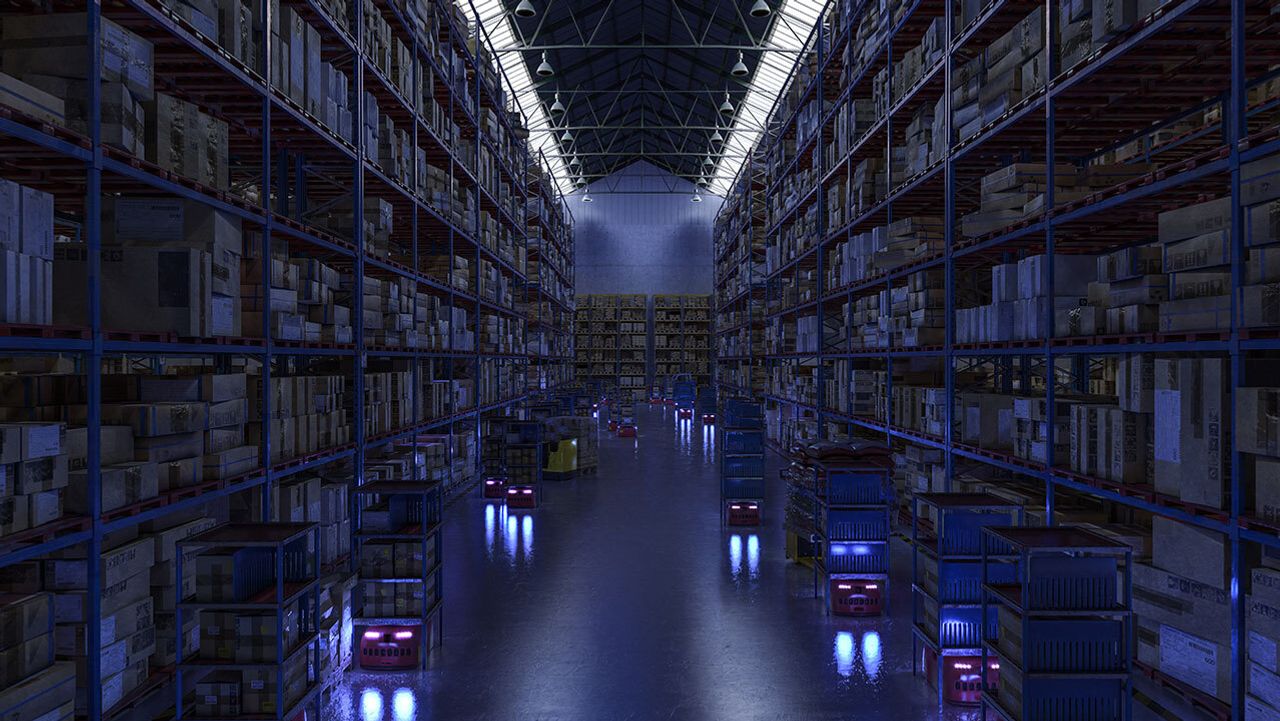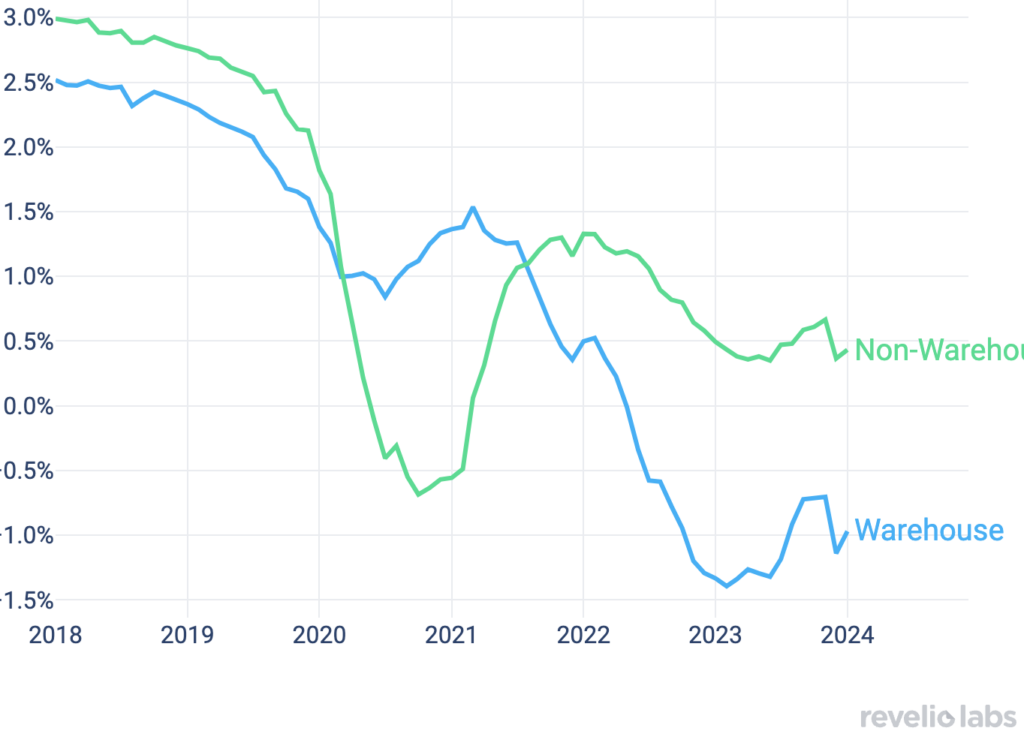Warehouse Worker Shortage Is Fueling Robotics Explosion

Catalant partnered with Revelio Labs, an industry leader in workforce intelligence, to develop this article. Revelio Labs absorbs and standardizes hundreds of millions of public employment records to create a database that helps people understand trends across large public companies and broader market trends. This piece was originally published in Revelio Labs’ newsroom and was co-authored by the team at Catalant.
- Amid a warehouse labor shortage, companies are increasing automation efforts, with a noticeable uptick in job postings explicitly mentioning automation.
- Part of the automation efforts may be a response to the declining growth in warehouse-related positions: The growth rate of warehouse workers in the US has declined compared to other workers in the same companies.
- The decline in the growth of warehouse-related positions can be attributed to the physically and mentally demanding nature of these jobs. However, automation has the potential to create a safer and less stressful environment, which could entice more experienced warehouse workers to return to the profession.
Pandemic-induced disruptions, including lockdowns, health concerns, and the growth of e-commerce, have created a perfect storm of labor shortage within the warehouse sector. It’s not just that hiring is difficult – companies also face difficulties in retaining the workers they have.
Amid the ongoing supply chain shortage and the need for efficient logistics management, companies have been ramping up their automation efforts. In 2023, Catalant observed a significant 21% year-over-year increase in supply chain projects referencing artificial intelligence, machine learning, or automation. These strategic initiatives at the senior management level in supply chain automation closely correlate with the notable rise in warehouse-related job postings explicitly referencing automation, as seen in our analysis of Revelio Labs’ job postings data. The proportion of warehouse-related job postings in the US explicitly mentioning automation has increased sharply to 25.6% in January 2024.
A higher share of ware-house related postings mention automation
Share of new ware-house related postings that mention automation

One reason that companies are adopting automation in their warehouses is to support increased inventory demand and the need to reposition inventory. As Robert Gates, Catalant expert on logistics and e-commerce warehouse management, notes:
Companies with large e-commerce businesses, like Amazon and Walmart, are now leveraging the broad footprint of fulfillment centers and dedicated resupply routes (via ground and air) to maintain high fulfillment rates and manage working capital. With dedicated air routes that not only distribute purchased goods but also reposition inventory to ship from the closest location to the end user, now, items get moved closer to the end-user and are boxed together, which yields economic synergy. Repositioning inventory requires automation to ensure the right items end up in the right place, reduce human error, and ensure worker safety. It used to be that warehouse workers just moved things around. Now they must comprehend, scan the right things, take the right paths, etc.
Automation efforts may also be a response to the declining growth in warehouse-related positions and the ongoing labor shortage. Using Revelio Labs’ workforce data, we examine how the number of US employees in warehouse-related positions has changed compared to the number of employees in other positions within the same companies. We find that the growth in the number of employees in warehouse roles has been lagging in recent years. It is interesting to note that during the height of the pandemic in 2020, the growth rate of warehouse workers didn’t drop as significantly as other positions. This was because warehouse workers were among the frontline workers, essential in maintaining supply chain logistics while much of the world came to a standstill. However, as other positions began to recover, the growth rate of warehouse-related positions started declining and never truly caught up. Since 2022, the growth rate has been negative, meaning the total number of warehouse employees in the US has been decreasing.
Warehouse-related jobs experienced lower growth
Growth-rate of employees in warehouse and non-warehouse positions

The decline in the growth of warehouse-related positions can be attributed to the fact that warehouse jobs can be demanding. They require physical stamina, attention to detail, and the ability to work efficiently in a fast-paced and often risky environment. Based on the list of frequently mentioned words in employee sentiment data, it is evident that these jobs often require long shifts, involve tedious and repetitive work, and include physical tasks such as heavy lifting, placing significant demands on employees’ physical and mental well-being.
Warehouse jobs are physically and mentally demanding
Words frequently mentioned in negative reviews among warehouse-related positions

While retraining and retaining can help existing warehouse workers adapt to technology faster, employers should also not be afraid of some workforce attrition that may occur during the process. According to Dr. Mitch Millstein, a Lean and Supply Chain Consultant working on the Catalant platform and a professor of supply chain management at the University of Missouri St. Louis studying technology adoption by warehouse workers, warehouse operators would do well to consider technology adoption as an optimization exercise:
Consider how far up the adoption curve you need to go to optimize the tradeoff of retaining the workers you have and recruiting the new ones you need to grow. Some classes of warehouse workers would rather quit their jobs than put on an AR (augmented reality) headset, whereas implementing more technology can attract a different class of warehouse workers, helping to boost recruiting.
Analyzing the set of individuals who started new positions as warehouse workers, we find that the share with prior warehouse-related experience is around 33%. In other words, the majority are being filled by workers without any prior warehouse experience. This new talent can bring a fresh perspective to the profession and is often more willing to adopt new technologies.
Nevertheless, we should not underestimate seasoned warehouse workers’ adaptability to new technologies. The share of workers staying within warehouse roles started to rise in 2023, coinciding with employers’ heightened emphasis on automation. Part of this resurgence in experienced warehouse workers returning to the profession can be attributed to their preference for and adaptability to new technologies.
More warehouse workers are remaining in warehouse positions
Share of new warehouse hires coming from another warehouse-related position

Contrary to popular belief, automation is not simply about replacing humans with robots; it is also about robots assisting humans. By relieving human workers of repetitive tasks, automation creates a safer and less stressful environment for warehouse workers. Moreover, it empowers workers to take on more sophisticated responsibilities, enhancing productivity and workplace satisfaction.
Meet the Author

Jin Yan has over a decade of experience as a specialist in supply chain finance, analytics, and operations management. She is a principal at RRDS Chicago — a data science and quantitative research company. Kara earned her undergraduate degree from Harvard and her MBA from The Wharton School of Business at the University of Pennsylvania.